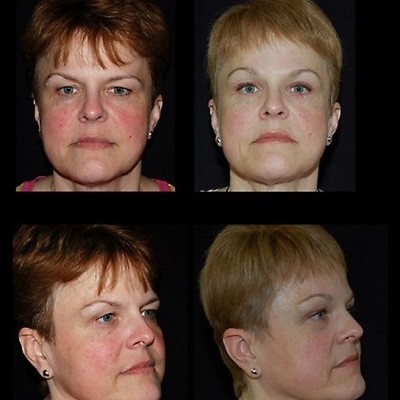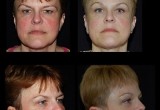Forehead Lift
The browlift procedure may be performed with an incision along the scalp hair line or with the use of an endoscope. The minimally invasive viewing technique allows for a the procedure to be performed with small incisions. Both techniques yield similar results; smoother forehead skin and a more awake appearance. If you are considering a forehead lift, the following will provide a basic understanding of the procedure -- when it can help, how it's performed and what results you can expect. It will not answer all of your questions, since much depends on your individual circumstances. Be sure to ask Dr. Baroody if there is anything you do not understand about the procedure.
THE BEST CANDIDATES FOR A FOREHEAD LIFT
A forehead lift is most commonly performed in the 40-60 age range to minimize the visible effects of aging. However, it can also help people of any age who have developed furrows or frown lines due to stress or muscle over activity. Individuals with inherited conditions, such as a low, heavy brow, or furrowed lines above the nose can achieve a more alert and refreshed look with this procedure. Forehead lift is often performed in conjunction with eyelid surgery (Blepharoplasty), especially if one has significant skin overhang the upper eyelids. Sometimes, those who believe they would benefit from upper eyelid surgery find that a forehead lift better meets their surgical goals. Those who have lost their hair, who have a receding hairline, or who have had previous upper-eyelid surgery may still be good candidates for forehead lift. Dr. Baroody will simply alter the incision location or perform a more conservative operation. Remember, a forehead lift can enhance your appearance and your self-confidence, but it will not necessarily change your looks to match your ideal or cause other people to treat you differently. Before you decide to have surgery, think carefully about your expectations and discuss them in detail with Dr. Baroody.
ALL SURGERY CARRIES SOME UNCERTAINTY AND RISK
Complications are rare and usually minor when a forehead lift is performed by a board certified plastic surgeon. However, the possibility of complications must be considered. In rare cases, the nerves that control eyebrow movement may be injured on one or both sides, resulting in a loss of ability to raise the eyebrows. Additional surgery may be required to correct the problem. Formation of a widened scar is also a rare complication. This may be treated surgically by removing the scar tissue so a new, thinner scar may result. Also, in some patients, hair loss may occur along the scar edges. Loss of sensation along or just beyond the incision line is common, especially with the classic forehead lift procedure. It is usually temporary, but may be permanent in some patients. Infection and bleeding are very rare, but are possibilities. If a complication should occur during an endoscopic forehead lift, Dr. Baroody may have to abandon the endoscopic approach and switch to the conventional, open procedure, which will result in a more extensive scar and a longer recovery period. To date, such complications are rare; estimated at less than 1 percent of all endoscopic procedures. You can reduce your risk of complications by closely following Dr. Baroody's instructions both before and after surgery.
PLANNING YOUR SURGERY
For a better understanding of how a forehead lift might change your appearance, look into a mirror and place the palms of your hands at the outer edges of your eyes, above your eyebrows. Gently draw the skin up to raise the brow and the forehead area. That is approximately what a forehead lift would do for you. During your consultation, Dr. Baroody will first evaluate your face, including the skin and underlying bone. He will discuss your goals for the surgery and ask you about certain medical conditions that could cause problems during or after the procedure, such as uncontrolled high blood pressure, blood-clotting problems, or the tendency to develop large scars. Be sure to tell Dr. Baroody if you have had previous facial surgery, if you smoke, or if you take any medications including aspirin and over the counter supplements. If a forehead lift is right for you, Dr. Baroody will explain the surgical technique, the type of anesthesia, the facility where the procedure may be performed. Do not hesitate to ask any questions you may have, especially those regarding your expectations and concerns about the results of surgery.
PREPARING FOR YOUR SURGERY
Dr. Baroody will give you specific instructions to prepare for the procedure, including guidelines on eating, drinking, smoking, and avoiding certain vitamins/medications. Carefully following these instructions will decrease your surgical risks and shorten your recovery time. If your hair is very short, you may wish to let it grow out before surgery to hide the scars while they heal. Whether your forehead lift is done in an outpatient facility or in the hospital, you should arrange
for someone to drive you home after surgery.
WHERE YOUR SURGERY WILL BE PERFORMED
A forehead lift is performed at Orthopaedic and Specialty Surgery Center or New Milford Hospital. Less involved types of forehead lifts may be performed under local anesthesia in the office setting.
ANESTHESIA USED FOR THE PROCEDURE
Less involved types of forehead lifts may be performed under local anesthesia. Most forehead lifts are performed under local anesthesia, combined with a sedative to make you drowsy. If the surgery is performed while under general anesthesia, you will be asleep through the entire operation.
THE SURGERY
Dr. Baroody will help you decide which surgical approach will best achieve your cosmetic goals: the classic open method, or the endoscopic forehead lift. Dr. Baroody elects the minimally invasive endoscopic procedure far more often than the open approach.
The classic forehead lift: The incision is placed just at the hairline. By wearing your hair down on your forehead, the scars become relatively inconspicuous. Special planning is sometimes necessary for concealing the scar in male patients, whose hairstyles often don't lend themselves as well to incision coverage. If you are losing your hair or have thinning hair, Dr. Baroody may recommend a mid-scalp incision so the resulting scar is less conspicuous. Working through the incision, the skin of the forehead is carefully lifted so that the underlying tissue can be removed and the muscles of the forehead can be altered or released. The eyebrows may also be elevated and excess skin at the incision point will be trimmed away to help create a smoother, more youthful appearance. The incision is then closed with stitches or clips. Your face and hair will be washed to prevent irritation.
The endoscopic forehead lift: Typically, an endoscopic forehead lift requires the same preparation steps as the traditional procedure. However, rather than making one long incision, Dr. Baroody will make three or five short scalp incisions, each less than an inch in length. An endoscope, which is a pencil-like camera device connected to a television monitor, is inserted through one of the incisions, allowing Dr. Baroody to have a clear view of the muscles and tissues beneath the skin. Using another instrument inserted through a different incision, the forehead skin is lifted and the muscles and underlying tissues are removed or altered to produce a smoother appearance. The eyebrows are lifted with an absorbable device. When the lift is complete, the scalp incisions will be closed with stitches or clips and the area will be washed. Gauze and an elastic bandage may also be used.
AFTER YOUR SURGERY
Endoscopic forehead lift patients may experience some numbness, incision discomfort and mild swelling. Incision site pain is usually minimal, but may be controlled with medication, if necessary. Endoscopic forehead lift patients usually experience less of the itching sensation felt by patients who have had the classic forehead lift. The immediate post-operative experience for a patient who has had a classic forehead lift may differ significantly from a patient who had the procedure performed endoscopically. Classic forehead lift patients may experience some numbness and temporary discomfort around the incision, which can be controlled with prescription medication. Patients who are prone to headaches may be treated with an additional longer-acting local anesthesia during surgery as a preventive measure. Keep your head elevated for 1 week following surgery to keep the swelling down. Swelling may also affect the cheeks and eyes; however, this should begin to disappear in a week. As the nerves heal, numbness on the top of your scalp may be replaced by itching. These sensations may take as long as six months to fully disappear. If bandages were used, they will be removed a day or two after surgery. Most stitches or clips will be removed within two weeks, sometimes in two stages. Some of your hair around the incision may fall out and may temporarily be a bit thinner. Normal growth will usually resume within a few weeks or months. Permanent hair loss is rare.
GETTING BACK TO NORMAL
Although you should feel well in a day or two, plan on taking it easy for at least the first week after surgery. You will be able to shower and shampoo your hair within two days. Most are back to work in a week to ten days. Vigorous physical activity should limited for four to six weeks, including jogging, bending, heavy housework, sex, or any activity that increases your blood pressure. Prolonged exposure to heat or sun should be limited for several months. Most of the visible signs of surgery should fade completely within about three weeks. Minor swelling and bruising can be concealed with makeup.
YOUR NEW LOOK
Most are pleased with the results of a forehead lift, no matter which surgical method was used. Often, patients do not realize how much their sagging forehead contributed to the signs of aging until they see how much younger and more rested they appear after the lift. Although a forehead lift does not stop the clock, it can minimize the appearance of aging for years.







